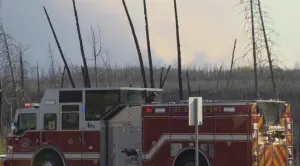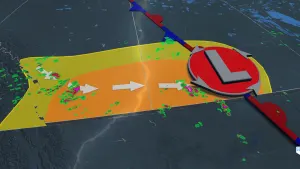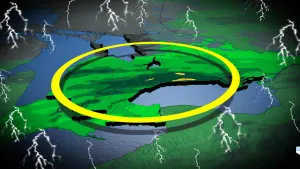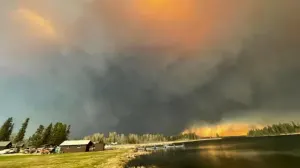
'Crazy': Massive ice chunks invade Alberta golf course

Nate Catto, spokesperson for the Fort McMurray Golf Course, stands in front of some of the ice chunks left by flooding Athabasca River. (Jamie Malbeuf/CBC)
The Fort McMurray Golf Club, preparing to open up, first has to figure out what to do about the huge ice chunks and piles of silt thrown onto the course by recent flooding.
The water flooded some of the golf course, with huge chunks deposited on two of the holes, and left inches of silt on others.
"I know I've sort of heard stories about river breakups doing stuff like this, but we have some staff here that have worked here 15, 16 years and never seen anything like that," said club spokesperson and executive chef Nate Catto.
"I think this is probably unprecedented for this golf course to see something this crazy."
Ice dams on the Athabasca and Clearwater rivers led to flooding in Fort McMurray damaging over 1,200 buildings. While the flooding has receded, a boil water advisory is in place for Fort McMurray, Anzac, Draper, Gregoire Lake Estates and Saprae Creek Estates.

The Fort McMurray Golf Club is trying to open for the season after a flood deposited huge chunks of ice onto the fairway. (Jamie Malbeuf/CBC)
The ice chunks stood feet above Catto's head on Monday, but the ice was even taller just a few days ago, he said.
The ice has been steadily melting as there's a layer of dark silt on top of the ice that absorbs the sun, Catto said.
"The water is running off them pretty good right now," he said. "Keep the nice weather up and these will be gone before you know it."

River silt sits on parts of the golf course. (Jamie Malbeuf/CBC)
When the ice does melt, the staff will have to hose off the silt and use squeegees to clean it up.
On top of that, two bridges were damaged during the ice heaves, with one broken in half and the other washed dozens of feet down the creek.
Catto said he didn't even know where the bridges ended up until recently, because the ice was covering them.
He said it's a matter of bringing in experts to figure out how to repair and reset the 120-foot, 10,000-pound bridges.
RELATED VIDEO: A CLOSER LOOK AT THE MASSIVE ICE JAM THAT'S FLOODING FORT MCMURRAY
Catto expects to open nine of the course's 27 holes within a week. It'll be about another week after that for the next nine holes, he said.
The driving range will open Tuesday at noon.
Jason Petrock, the courses's assistant superintendent, said this isn't the first disaster he's been through on the job.

Large chunks of ice cover two of the holes at the golf course. (Jamie Malbeuf/CBC)
In 2016, many of the club's buildings and equipment were burned in the wildfire.
"It's just another thing we have to deal with. It was shocking, that's for sure."
Right now staff are working on pumping out water that was leftover from the flooding, as well as cleaning up debris.
Volunteers are coming out to help clean up the course.
"I haven't dealt with this to this scale before. It will be a learning experience."
WATCH BELOW: WHAT IS AN ICE JAM? ARE ICE JAMS DANGEROUS?
RELATED: Fort McKay First Nation man dies as flooding overwhelms Fort McMurray
In the meantime, Catto has been helping prepare for the physical-distancing guidelines required for opening during the COVID-19 pandemic.
All of the balls at the driving range will be sanitized between each golfer, the halfway house will serve food and drinks take-out style and there is a flag system to identify people who live in the same household, he said.
This article was originally published for CBC News.









